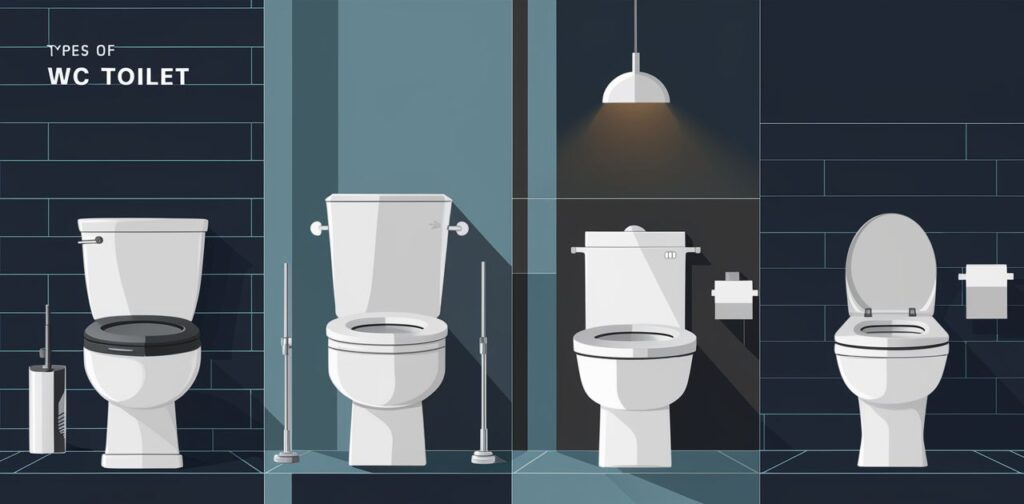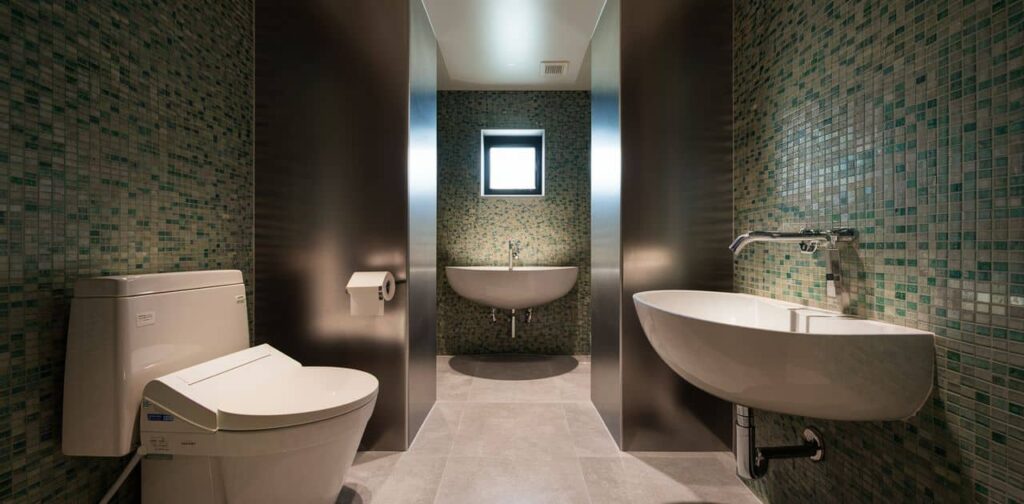Have you ever wondered what the letters “WC” stand for on bathroom signs? Or why some places refer to a toilet as a “Water Closet”? These terms may seem confusing, but they have a fascinating history dating back to the late 18th century. In this article, we’ll explore the origins of the term “Water Closet,” what it means, and how it relates to modern-day bathrooms and toilet facilities. We’ll also delve into the different components of a WC suite and clarify the distinctions between a toilet, a WC, and a full bathroom.
What is a WC Suite?
Whether you have heard the term WC Suite before or not, you’re probably wondering exactly what one is, or even what the abbreviation WC stands for. Well, wonder no more as this article explains all.
Why are toilets called a WC?
To start, WC is an abbreviation standing for ‘water closet‘, a name used in the 1900’s for a toilet, due to most being fitted in a spare closet or cupboard. Over time WC has been used instead of bathroom to describe a room with a toilet but no bath.
WC suite
Put simply, a WC suite is simply another term for a complete toilet with a cistern, pan, and flush. The term suite in this context is perhaps a little confusing as a suite is normally more than one item such as a sofa and an armchair or a bath, toilet, and basin, but just remember a WC suite refers to a full toilet system.
What is a WC or toilet pan?
The toilet or WC pan is the part of the toilet which contains the water and comes in a range of shapes and sizes, with standard and short projection toilets to offer. Short projection pans are perfect for smaller bathrooms as they take up less space from the front of the pan to the wall.
What is a WC or toilet cistern?
Cisterns can either be fitted as exposed or concealed depending on the toilet you choose and the shape and positioning of your bathroom. If your bathroom or WC is on the small side then a concealed cistern is a great option, allowing you to hide the full cistern and workings in the wall behind your toilet. An exposed cistern, however, is perfect if you’re going for a traditional look in your bathroom, as most classic toilets have beautiful exposed or raised cisterns.
WC Bathroom Sign
In many parts of Europe, you’ll often see signs with the letters “WC” instead of the word “toilet” or “bathroom.” This can be confusing for travelers and visitors who are unfamiliar with the term. The letters “WC” stand for “Water Closet,” which is an old-fashioned term for a toilet or a small room containing a toilet.
Why is a toilet called a WC?
The term “Water Closet” dates back to the late 18th century when indoor toilets were first introduced in wealthy households. These early toilets were often placed in small rooms or closets, hence the name “Water Closet.” Over time, the abbreviation “WC” became a common way to refer to a toilet, especially in public places and on signage.
WC Toilet Types

There are several different types of WC toilets, including:
- Close-coupled toilets: These have the cistern directly attached to the pan, creating a sleek, compact design.
- Back-to-wall toilets: These have the cistern concealed within the wall or a furniture unit, creating a modern, streamlined look.
- Wall-hung toilets: These are mounted directly on the wall, creating a space-saving and easy-to-clean design.
- Corner toilets: These are designed to fit into the corner of a room, maximizing space in smaller bathrooms.
Related Post: Top 10 Contemporary Bathroom Styles & Designs
WC Toilet Parts
A typical WC suite consists of the following parts:
- Toilet pan: This is the bowl-shaped part that holds the water and waste.
- Cistern: This is the tank that holds the water for flushing.
- Flush mechanism: This is the button, lever, or handle that initiates the flushing process.
- Toilet seat: This is the removable seat that covers the pan for comfort and hygiene.
- Toilet lid: This is the cover that goes over the toilet seat, helping to keep the toilet clean and improving the overall aesthetics.
What does WC stand for in Europe?
In Europe, the abbreviation “WC” stands for “Water Closet,” which is an old-fashioned term for a toilet or a small room containing a toilet. This term originated in the late 18th century when indoor toilets were first introduced in wealthy households.
WC Toilet Seat
The toilet seat is an important part of the WC suite, as it provides comfort and hygiene for users. There are several different types of toilet seats available, including:
- Standard toilet seats: These are the most common and affordable option, made from durable materials like plastic or wood.
- Soft-close toilet seats: These have hinges that gently lower the seat to prevent slamming and reduce noise.
- Heated toilet seats: These have built-in heating elements to provide warmth and comfort, especially in colder climates.
- Bidet toilet seats: These combine a toilet seat with bidet functionality for added hygiene and cleanliness.
Does “WC” mean washroom or toilet? If so, why?
The abbreviation “WC” stands for “Water Closet,” which is an old-fashioned term for a toilet or a small room containing a toilet. It does not refer to a washroom or a bathroom with a sink and other fixtures. The term originated in the late 18th century when indoor toilets were first introduced in wealthy households and were often placed in small rooms or closets, hence the name “Water Closet.”
Why is a public WC called “bathroom” if there is no bath?
In some regions, particularly in North America, the term “bathroom” is commonly used to refer to a room containing a toilet, even if there is no bathtub or shower present. This usage can be confusing, as the term “bathroom” implies the presence of a bath or shower.
The reason for this terminology is rooted in history and cultural differences. In many homes and buildings, the room containing the toilet was often the same room that contained a bathtub or shower. Over time, the term “bathroom” became a catch-all phrase for any room containing toilet facilities, regardless of whether a bath or shower was present.
In other parts of the world, such as Europe, there is a clearer distinction between a “bathroom” (a room with a bathtub or shower) and a “WC” or “toilet” (a room containing only a toilet). This distinction helps avoid confusion and provides more accurate terminology for different types of facilities.
What does WC mean in bathroom?
In the context of bathrooms, the abbreviation “WC” stands for “Water Closet,” which is an old-fashioned term for a toilet or a small room containing a toilet. This term originated in the late 18th century when indoor toilets were first introduced in wealthy households and were often placed in small rooms or closets, hence the name “Water Closet.”
When you see the letters “WC” on a sign or in a building, it typically indicates the location of a toilet or a restroom facility, rather than a full bathroom with additional fixtures like a sink, bathtub, or shower.
What is the difference between a toilet and a WC bathroom?
The terms “toilet” and “WC bathroom” are often used interchangeably, but there is a slight difference in their meanings:
- Toilet: This refers specifically to the fixture itself, which is used for the disposal of human waste. It consists of a bowl or pan, a water tank or cistern, and a flushing mechanism.
- WC bathroom: This refers to a room or small space that contains a toilet, also known as a “Water Closet” (WC). A WC bathroom may or may not include additional fixtures like a sink or a shower, but its primary purpose is to provide a private space for using the toilet.
In summary, a toilet is the specific fixture, while a WC bathroom is the room or space that houses the toilet. The term “WC bathroom” is more commonly used in certain regions, particularly in Europe, to distinguish between a room with just a toilet and a full bathroom that includes additional fixtures like a bathtub or shower.
What does WC stand for on bathroom signs?
On bathroom signs, particularly in Europe, the letters “WC” stand for “Water Closet,” which is an old-fashioned term used to refer to a toilet or a small room containing a toilet. This terminology dates back to the late 18th century when indoor toilets were first introduced in wealthy households and were often placed in small rooms or closets, hence the name “Water Closet.”
Where does WC stand for?
The abbreviation “WC” stands for “Water Closet,” which is an old-fashioned term for a toilet or a small room containing a toilet. This term originated in the late 18th century when indoor toilets were first introduced in wealthy households and were often placed in small rooms or closets, hence the name “Water Closet.”
Why are bathrooms called WC in Germany?
In Germany, as well as many other European countries, the term “WC” is commonly used to refer to a room or facility containing a toilet. This is because “WC” is an abbreviation for “Water Closet,” which is an old-fashioned term for a toilet or a small room housing a toilet.
The use of “WC” to refer to a toilet or bathroom facility dates back to the late 18th century when indoor toilets were first introduced in wealthy households. These early toilets were often placed in small rooms or closets, hence the name “Water Closet.” Over time, the abbreviation “WC” became a common way to refer to a toilet, especially in public places and on signage.
In Germany, as in many other European countries, there is a clear distinction between a “bathroom” (a room with a bathtub or shower) and a “WC” (a room containing only a toilet). This distinction helps avoid confusion and provides more accurate terminology for different types of facilities.
Additional information regarding WC Bathroom
The Evolution of Indoor Toilets and the Water Closet
From the earliest indoor toilets in wealthy homes to modern fixtures, the water closet has undergone a remarkable transformation to become an essential part of bathroom design.
Components of a Modern WC Suite
A contemporary WC suite typically includes a toilet bowl, a cistern or tank, a flushing mechanism, a toilet seat, and sometimes a bidet for added hygiene and comfort.
Cultural Differences in Bathroom Terminology
While “WC” is common in Europe, North America favors “bathroom” or “restroom,” highlighting the cultural variations in terminology for toilet facilities across different regions.
Navigating Bathroom Signage and Terminology When Traveling
When traveling, being familiar with common bathroom signage and terminology like “WC” can help avoid confusion and ensure a smooth experience when seeking out toilet facilities.
The Importance of Clear and Accurate Bathroom Labels
Clear and accurate labeling of bathroom facilities is crucial for accessibility, inclusivity, and preventing misunderstandings, especially in public spaces and international contexts.
The Future of Bathroom Design and Terminology
As bathroom design evolves, terminology may adapt to reflect new innovations, sustainability efforts, and changing cultural norms, ensuring clear communication about these vital facilities.
FAQ’s
Does “WC” mean washroom or toilet?
“WC” stands for “Water Closet,” which is an old-fashioned term specifically referring to a toilet or a small room containing a toilet, not a full washroom or bathroom.
Why is a public WC called “bathroom” if there is no bath?
In some regions, the term “bathroom” is used as a catch-all phrase for any room containing toilet facilities, even if there is no bathtub or shower present. This usage can be confusing and is rooted in cultural differences and historical terminology.
What is the difference between a toilet and a WC bathroom?
A toilet refers to the specific fixture used for the disposal of human waste, while a WC bathroom refers to the room or space that houses the toilet, also known as a “Water Closet.”
Why do bathrooms in Europe say WC?
In many parts of Europe, there is a clear distinction between a “bathroom” (a room with a bathtub or shower) and a “WC” (a room containing only a toilet). The term “WC” is an old-fashioned abbreviation for “Water Closet,” referring to the early indoor toilets placed in small rooms or closets.
What does WC stand for on bathroom signs?
On bathroom signs, particularly in Europe, the letters “WC” stand for “Water Closet,” which is an old-fashioned term used to refer to a toilet or a small room containing a toilet.
Conclusion
In conclusion, the term “WC” or “Water Closet” may seem outdated, but it has a rich history that dates back to the late 18th century when indoor toilets were first introduced in wealthy households. The abbreviation “WC” became a common way to refer to a toilet or a small room housing a toilet, especially in public places and on signage. While the terminology may vary across regions, with some using “bathroom” as a catch-all term, it’s important to understand the distinction between a “WC” and a full bathroom with additional fixtures like sinks, bathtubs, or showers. By understanding the origins and meanings of these terms, we can better appreciate the evolution of toilet facilities and navigate different bathroom signage and terminology, especially when traveling to different parts of the world.







